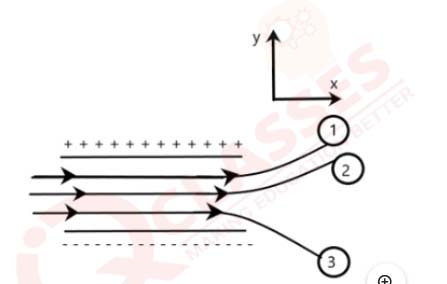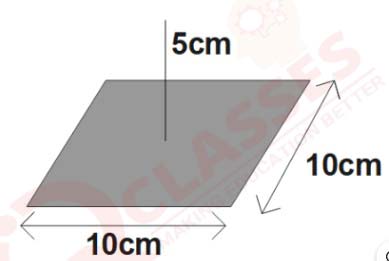Q1
What is the force between two small charged spheres having charges of 2 × 10-7C and 3 ×
10-7 C
placed 30 cm apart in the air?
solutions
solutions

Q2
The electrostatic force on a small sphere of charge is 0.4 µC due to another small sphere of charge
–0.8 µC in the air is 0.2 N.
(a) What is the distance between the two spheres?
(b) What is the force on the second sphere due to the first?
solutions

(a) What is the distance between the two spheres?
(b) What is the force on the second sphere due to the first?
solutions


Q3
Check that the ratio ke2/G memp is dimensionless. Look up a Table
of Physical Constants and
determine the value of this ratio. What does the ratio signify?
solutions

solutions


Q4
(i) Explain the meaning of the statement ‘electric charge of a body is quantised’.
(ii) Why can one ignore the quantisation of electric charge when dealing with macroscopic, i.e. large-scale charges?
solutions

(ii) Why can one ignore the quantisation of electric charge when dealing with macroscopic, i.e. large-scale charges?
solutions


Q5
When a glass rod is rubbed with a silk cloth, charges appear on both. A similar phenomenon is
observed with many other pairs of bodies. Explain how this observation is consistent with the law of
conservation of charge.
solutions

solutions


Q6
Four point charges qA = 2 µC, qB = -5 µC,qC = 2 µC,qD =
-5 µC, are located at the corners of a square ABCD of side 10 cm. What is the force on a charge of 1
µC placed at the centre of the square?
solutions


solutions



Q7
(i) An electrostatic field line is a continuous curve. That is, a field line cannot have sudden
breaks. Why not?
` (ii) Explain why two field lines never cross each other at any point.
solutions

` (ii) Explain why two field lines never cross each other at any point.
solutions


Q8
Two point charges qA = 3 µC and qB= –3 µC are located 20 cm apart in a vacuum.
(i) What is the electric field at the midpoint O of the line AB joining the two charges?
(ii) If a negative test charge of magnitude 1.5 × 10-9 C is placed at this point, what is the force experienced by the test charge?
solutions


(i) What is the electric field at the midpoint O of the line AB joining the two charges?
(ii) If a negative test charge of magnitude 1.5 × 10-9 C is placed at this point, what is the force experienced by the test charge?
solutions



Q9
A system has two charges qA=2.5 x 10-7 C and qB=-2.5 x
10-7 C located at points A: (0, 0, -15 cm) and B (0, 0, + 15 cm), respectively. What are
the total charge and electric dipole moment of the system?
solutions

solutions


Q10
An electric dipole with dipole moment 4 x 10-9C m is aligned at 30° with the direction of
a uniform electric field of magnitude 5 x 104NC-1. Calculate the magnitude of
the torque acting on the dipole.
solutions
solutions

Q11
A polythene piece rubbed with wool is found to have a negative charge of 3 x 10-7 C.
(i) Estimate the number of electrons transferred (from which to which?).
(ii) Is there a transfer of mass from wool to polythene?
solutions

(i) Estimate the number of electrons transferred (from which to which?).
(ii) Is there a transfer of mass from wool to polythene?
solutions


Q12
(i) Two insulated charged copper spheres, A and B, have their centres separated by a distance of 50
cm. What is the mutual force of electrostatic repulsion if the charge on each is 6.5 x
10-7 each? The radii of A and B are negligible compared to the distance of
separation.
(ii) What is the force of repulsion if each sphere is charged double the above amount, and the
distance between them is halved?
solutions


solutions



Q13
Suppose the spheres A and B in Exercise 12 have identical sizes. A third sphere of the same size but
uncharged is brought in contact with the first, then brought in contact with the second, and finally
removed from both. What is the new force of repulsion between A and B?
solutions


solutions



Q14
The figure below shows tracks of three charged particles in a uniform electrostatic field. Give the
signs of the three charges. Which particle has the highest charge-to-mass ratio?

solutions


solutions


Q15
Consider a uniform electric field E = 3 × 103 î N/C.
(a) What is the flux of this field through a square of 10 cm on a side whose plane is parallel to the y z – plane?
(b) What is the flux through the same square if the normal to its plane makes a 60 ° angle with the x-axis?
solutions

(a) What is the flux of this field through a square of 10 cm on a side whose plane is parallel to the y z – plane?
(b) What is the flux through the same square if the normal to its plane makes a 60 ° angle with the x-axis?
solutions


Q16
What is the net flux of the uniform electric field of Exercise 1.15 through a cube of side 20 cm
oriented so that its faces are parallel to the coordinate planes?
solutions
solutions

Q17
Careful measurement of the electric field at the surface of a black box indicates that the net
outward flux through the surface of the box is 8.0 × 10 3 N m 2 /C.
(a) What is the net charge inside the box?
(b) If the net outward flux through the surface of the box were zero, could you conclude that there were no charges inside the box? Why or Why not?
solutions

(a) What is the net charge inside the box?
(b) If the net outward flux through the surface of the box were zero, could you conclude that there were no charges inside the box? Why or Why not?
solutions


Q18
A point charge + 10 μC is at a distance 5 cm directly above the centre of a square of side 10 cm, as
shown in Fig. 1.34. What is the magnitude of the electric flux through the square?
solutions

solutions


Q19
What is the force between two small charged spheres having charges of 2 × 10-7C and 3 ×
10-7 C
placed 30 cm apart in the air?

solutions


solutions


Q19
A point charge of 2.0 μC is at the centre of a cubic Gaussian surface 9.0 cm on edge. What is the
net electric flux through the surface?
solutions
solutions

Q20
A point charge causes an electric flux of – 1.0 × 10 3 N m 2 /C to pass
through a spherical Gaussian surface of a 10.0 cm radius centred on the charge.
(a) If the radius of the Gaussian surface were doubled, how much flux would pass through the surface?
(b) What is the value of the point charge?
solutions

(a) If the radius of the Gaussian surface were doubled, how much flux would pass through the surface?
(b) What is the value of the point charge?
solutions


Q21
A conducting sphere of radius 10 cm has an unknown charge. If the electric field 20 cm from the
centre of the sphere is 1.5 × 10 3 N/C and points radially inward, what is the net charge
on the
sphere?
solutions
solutions

Q22
A uniformly charged conducting sphere of 2.4 m diameter has a surface charge density of 80.0 μC /m
2
(a) Find the charge on the sphere.
(b) What is the total electric flux leaving the surface of the sphere?
solutions

(a) Find the charge on the sphere.
(b) What is the total electric flux leaving the surface of the sphere?
solutions


Q23
An infinite line charge produces a field of 9 × 10 4 N/C at a distance of 2 cm. Calculate
the linear
charge density.
solutions

solutions


Q24
Two large, thin metal plates are parallel and close to each other. On their inner faces, the plates
have surface charge densities of opposite signs and magnitude 17.0 × 10 -22 C /m
2
What is E:
(a) In the outer region of the first plate?
(b) In the outer region of the second plate and (c) between the plates?
solutions


What is E:
(a) In the outer region of the first plate?
(b) In the outer region of the second plate and (c) between the plates?
solutions


